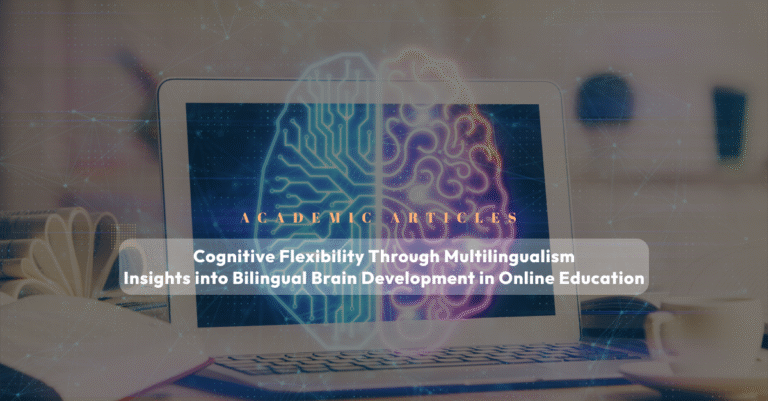Neuroscience of Language Acquisition
From infancy through early childhood which is the peak period of neuroplasticity, the bilingual brain undergoes measurable structural changes in response to multilingual learning.
Bilinguals typically show increased grey matter density in the inferior parietal cortex and anterior cingulate cortex, regions tied to language control and conflict monitoring. They also develop enhanced white matter connectivity, reflecting more efficient neural communication across brain networks.
For instance, brain imaging studies reveal that early learners tend to have more robust grey matter density than those who acquire additional languages later, while lifelong bilingual use boosts myelination in key white matter tracts. These changes support better switching between language systems and greater cognitive resilience.
Executive Function & Cognitive Flexibility
Decades of research, particularly from Ellen Bialystok and colleagues, show that bilingual children outperform monolingual peers in executive functions — especially inhibitory control, task switching, and working memory.
In dual-modality tasks requiring coordination of multiple cognitive control systems, bilingual children show notably higher accuracy.
Cognitive flexibility — the capacity to shift mental sets effectively — is likewise enhanced in bilinguals. Those managing more than one language practice constant switching and inhibition, reinforcing their ability to adapt and refocus cognitively.
Impact on Creativity and Problem-Solving

Recent studies show that cognitive flexibility and inhibition mediate bilingualism’s effect. High‑proficiency bilinguals outperform their low‑proficiency peers in both convergent (logical, analytic) and divergent (novel, flexible) thinking tasks. Cognitive inhibition bolsters convergent thinking, while cognitive flexibility enhances divergent thinking.
Thus, managing two or more languages appears to train the brain’s capacity to think both convergently (focused problem-solving) and divergently (creative exploration).
Benefits in Online K–12 Learning Environments
Online education brings unique cognitive demands: rapid task-switching, sustained attention across diverse digital formats, and strategic planning.
Multilingual learners, already adept at juggling multiple languages, may transfer their neural strengths to thrive in virtual classrooms:
- Attention control and multitasking: Bilingual students are typically better at ignoring distractions and switching tasks, skills essential for navigating many online learning platforms.
- Working memory advantages: Managing vocabulary and grammar in multiple languages strengthens working memory—useful when following lessons across various subjects.
- Metalinguistic awareness: Awareness of language structures transfers across modalities, helping multilingual learners decode written and verbal input more effectively.
Cognitive gains reinforce self-regulation, organization, and adaptability, practical assets in self-paced and remote learning contexts.
Educational Implications and Considerations
Promote Early Multilingual Exposure
Status as an early bilingual correlates with stronger executive function and neural development.
Even within virtual K–12 programs, integrating bilingual or immersion tracks can amplify developmental benefits..
Account for Differential Outcomes
While the benefits of bilingualism are robust, some studies report mixed findings, especially in adults or lower‑proficiency learners.
Factors like age at acquisition, socio‑economic status, language similarity, and overall proficiency level are also important.
Build supportive online learning designs
Online K–12 programs can embed scaffolds (e.g., repeated prompts, scaffolded language support, mindful pacing) that help bilingual learners leverage cognitive benefits while mitigating potential interference or overload.
Long-Term Cognitive Resilience
Longitudinal research underscores bilingualism’s protective role in aging: lifelong multilingual speakers often delay dementia onset by 4 to 5 years, with preserved hippocampal volume and executive network integrity.
This implies that early investment in multilingual learning enhances present-day cognitive flexibility and creative thinking in online or traditional schooling and contributes to lasting brain health and resilience.
Conclusion
Multilingualism exerts a powerful influence on brain development, enhancing executive function, cognitive flexibility, working memory, and creative reasoning. In online K–12 environments, multitasking, self‑management, and adaptability are crucial. Bilingual learners may harness these neural advantages to excel academically and gain lifelong cognitive resilience.
As neuroscience converges with educational trends, it becomes clear that encouraging early and sustained multilingualism in virtual learning contexts can catalyze cognitive flexibility and a foundation for enhanced education outcomes and brain health.
Share, Discuss, or Ask
Do you have a child in an online school, or are you considering enrolling your child in one? We’d love to hear about your experiences. Let us know what has been or may be decisive in the dilemma of Traditional vs. Online.
If you have questions, please visit us at EduWW or email [email protected].email [email protected].



